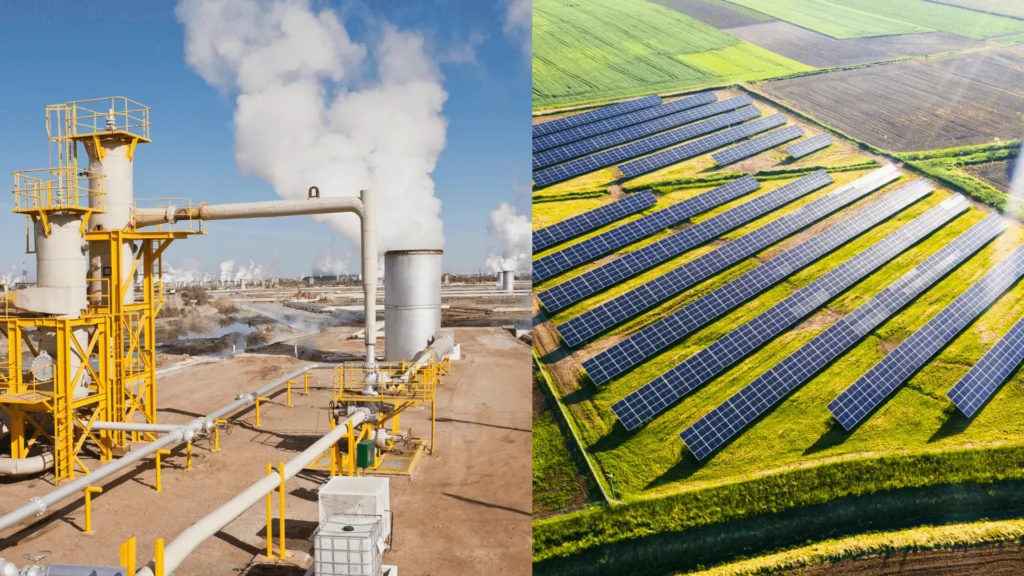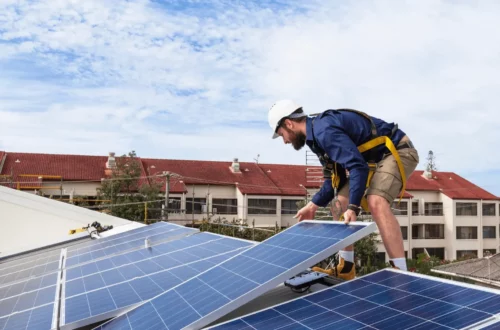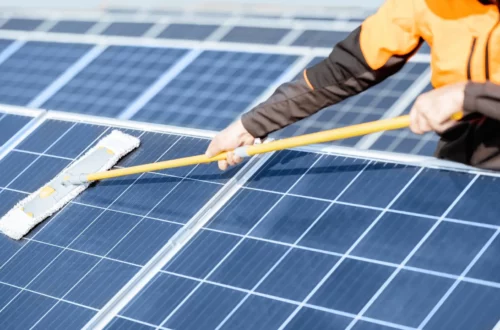What Does Geothermal and Solar Energy Have in Common?

Did you know that geothermal and solar energy have more in common than you might think? These sustainable power options share several similarities, from their efficiency and renewable nature to their positive impact on the environment. If you’re curious about how these two renewable energy sources compare, you’re in the right place!
In this article, we’ll dive into the seven key similarities between geothermal and solar energy. We’ll explore their ability to power homes and businesses, their cost-saving potential, and the long lifespan they offer. Additionally, we’ll discuss the job opportunities that arise from these sustainable power options and their contributions to the fight against climate change.
So, whether you’re considering installing solar panels or exploring geothermal energy, this article will provide you with all the insights you need to make an informed decision. Let’s dive in and uncover the common ground between these environmentally friendly power sources.
Similarity 1: Both Can Power Homes and Businesses
Geothermal energy and solar energy offer viable solutions for meeting the energy needs of both homes and businesses.
Harnessing Geothermal Energy
Geothermal energy utilizes heat from the Earth’s core to generate power. Through geothermal power plants, this renewable resource is converted into electricity, which can be distributed to residential and commercial properties. Geothermal power plants tap into the Earth’s natural heat by drilling wells to access hot water or steam. This heat is then used to rotate turbines, which generate electricity.
Leveraging Solar Power
Solar energy, on the other hand, harnesses the sun’s abundant rays to convert sunlight into electricity. Solar panels, typically mounted on rooftops or placed in open areas, capture sunlight through photovoltaic cells. These cells then generate an electric current, which can be used to power homes and businesses. Solar energy can be fed into the grid for widespread usage or stored in batteries for use during times of low sunlight.
Also read: Adding Solar Panels to Existing System: Maximizing Your Solar Energy System
Similarity 2: Renewable Energy
Both geothermal and solar energy are prime examples of renewable energy sources that harness the power of nature to generate electricity. The renewable nature of these energy sources stems from their ability to replenish themselves naturally over time. Unlike fossil fuels, which are finite resources and contribute to greenhouse gas emissions, geothermal and solar energy offer clean, sustainable alternatives.
Geothermal Energy as a Renewable Resource
Geothermal energy taps into the Earth’s heat stored in the core and harnesses it to generate electricity. This heat is a truly renewable resource as it constantly replenishes itself due to the natural processes occurring within the Earth.
Solar Energy as an Environment-Friendly Option
Solar energy harnesses the power of the sun to generate electricity. The sun, a massive fusion reactor, provides an abundant and renewable source of energy. By utilizing solar panels, which convert sunlight into electrical energy through the photovoltaic effect, solar power systems generate electricity without depleting any resources.
Also read: How Long Does It Take To Install Solar Panels: A Comprehensive 2023 Guide
Similarity 3: Environment-Friendly Power Sources
When it comes to environmental impact, both geothermal and solar energy emerge as highly viable and eco-friendly options. These renewable energy sources play a significant role in reducing the emission of greenhouse gases and minimizing our carbon footprint.
Reducing Greenhouse Gas Emissions
Geothermal energy harnesses the heat from within the Earth’s core, utilizing it to generate electricity or for direct heating purposes. This process releases minimal to no greenhouse gases, making it an environmentally friendly power source. Geothermal power plants emit relatively low levels of carbon dioxide, sulfur dioxide, and other pollutants compared to traditional fossil fuel-based power plants. Additionally, the technology used in geothermal systems minimizes heat escape, ensuring optimal efficiency and fewer emissions.
Similarly, solar energy harnesses the abundant sunlight to generate electricity. Solar panels convert sunlight into electricity through the photovoltaic effect, without any emissions or waste products. This nature of solar energy substantially reduces greenhouse gas emissions, making it a clean alternative to fossil fuel-based power sources.
Also read: Increased Energy Efficiency Ultimately Leads to Lower Costs
Similarity 4: Cost Savings Over Time
When considering renewable energy options, such as geothermal and solar energy, one notable similarity is the potential for cost savings over time. While the upfront costs of installing geothermal or solar energy systems may be higher compared to traditional energy sources, the long-term benefits and savings make them a worthwhile investment.
1. Lower Operating Costs:
Both geothermal and solar energy systems have significantly lower operating costs compared to conventional energy sources. Geothermal systems utilize the natural heat from the Earth’s core, which means a constant supply of free and renewable energy. Solar energy systems harness the power of the sun, providing an abundant energy source without relying on costly fossil fuels.
2. Reduced Energy Bills:
By switching to geothermal or solar energy, homeowners and businesses can drastically reduce their monthly energy bills. Geothermal systems can heat or cool a building more efficiently than traditional HVAC systems, resulting in substantial energy savings. Solar panels, on the other hand, generate electricity that can offset or even eliminate the reliance on grid-supplied power, resulting in significant cost reductions.
3. Government Incentives and Tax Credits:
Another cost-saving factor for both geothermal and solar energy systems comes in the form of government incentives and tax credits. Many countries and regions offer financial incentives to encourage the adoption of renewable energy sources. These incentives can help offset the initial installation costs, making geothermal and solar energy systems more affordable for homeowners and businesses.
Also read: Upgrade Your Home’s Energy Efficiency with These 12 Easy Steps
Similarity 5: Long Lifespan
Both geothermal and solar energy systems boast a remarkable longevity, making them highly valuable investments in the renewable energy landscape.
Geothermal Energy Systems
Geothermal energy systems are known for their exceptionally long lifespan. With proper maintenance and care, geothermal heat pumps can easily last for more than 20 years. In fact, many geothermal systems have been in operation for over 50 years, showcasing their robustness and durability. This longevity is primarily due to the minimal moving parts involved in geothermal systems, reducing the risk of wear and tear. As a result, homeowners and businesses can rely on geothermal energy to provide reliable heating, cooling, and hot water services for several decades.
Solar Energy Systems
Similarly, solar energy systems have an impressive lifespan. Solar panels, the main component of solar energy systems, are typically warranted for 25 to 30 years. However, many panels continue to generate electricity well beyond their warranty period, often remaining operational for 30 years or more. The durable construction of solar panels allows them to withstand various weather conditions, including hail, heavy rain, and snow. This resilience ensures long-term energy production, offering a reliable and sustainable source of electricity for homes and businesses.
Also read: Why You Should Consider Solar Energy for Your Home | Advantages of Solar Energy
Similarity 6: Job Opportunities
Both the geothermal and solar energy sectors offer promising job opportunities within the renewable energy industry. As the world shifts towards sustainable power sources, the demand for skilled professionals in these sectors continues to grow.
Job Roles in the Geothermal Energy Sector
In the geothermal energy sector, various job roles have emerged due to the development and operation of geothermal power plants. These include:
1. Geothermal Engineers: These professionals specialize in designing and developing geothermal power plants, ensuring efficient utilization of the Earth’s heat to generate electricity.
2. Geologists: Geologists play a crucial role in identifying suitable locations for geothermal power plants by studying the Earth’s subsurface geological structures.
3. Drillers and Technicians: These individuals are responsible for drilling wells and maintaining geothermal power plant equipment.
4. Power Plant Operators: These professionals monitor and maintain the day-to-day operations of geothermal power plants, ensuring smooth and efficient power generation.
Job Opportunities in the Solar Energy Sector
The solar energy sector has witnessed significant growth globally, leading to numerous job opportunities. Some of the key job roles in the solar energy industry include:
1. Solar Installation Technicians: These professionals install solar panels and associated equipment, ensuring proper setup for efficient energy production.
2. Solar Designers: Solar designers utilize their expertise to create cost-effective and energy-efficient solar panel systems for residential and commercial applications.
3. Solar Project Managers: Project managers oversee the planning and execution of solar energy projects, coordinating various stakeholders and ensuring successful project completion.
4. Sales and Marketing Professionals: These individuals play a crucial role in promoting solar energy systems, educating customers about the benefits and facilitating the adoption of solar solutions.
The renewable energy transition is driving job creation in both geothermal and solar energy sectors. With the growing demand for alternative energy sources, these sectors offer exciting career opportunities for individuals passionate about sustainable energy.
Also read: How Renewable Energy is Transforming the Environment: 5 Major Benefits
Similarity 7: The Fight Against Climate Change
Geothermal and solar energy play a crucial role in the global fight against climate change. Both renewable energy sources offer sustainable alternatives to traditional fossil fuel-based power generation, significantly reducing greenhouse gas emissions and mitigating the negative impact on the environment.
By harnessing the Earth’s natural heat, geothermal energy systems provide a reliable and constant power source without contributing to carbon emissions. Geothermal power plants utilize the heat stored beneath the Earth’s surface to generate electricity, offering a renewable resource that can supplement or even replace traditional energy sources.
Solar energy, on the other hand, harnesses the power of the sun through solar panels to convert sunlight into electricity. This clean and abundant source of energy significantly reduces reliance on fossil fuels and effectively reduces the carbon footprint associated with power generation.
Through their emissions-free operation and sustainable power production methods, both geothermal and solar energy systems contribute to a significant reduction in greenhouse gas emissions. By transitioning towards these environmentally friendly sources of energy, we can collectively combat climate change and work towards a more sustainable future.
The adoption of geothermal and solar energy systems has gained significant attention and support, with countries around the world recognizing the need to transition away from traditional energy sources. As governments and organizations prioritize renewable energy solutions, geothermal and solar technologies have experienced rapid growth, creating job opportunities throughout the energy sector and supporting the global transition to a low-carbon economy.
Also read: Disadvantages of Geothermal Energy: A Comprehensive Guide
Conclusion
Geothermal and solar energy share several key similarities that make them attractive options for a sustainable future. Both geothermal and solar energy can power homes and businesses, providing reliable and clean electricity. They are renewable energy sources, harnessing naturally occurring resources that are continuously replenished, reducing our reliance on fossil fuels. Moreover, geothermal and solar energy are environmentally friendly power sources, emitting minimal greenhouse gases and contributing to the fight against climate change.
Cost savings over time are also a common feature of geothermal and solar energy systems. Although the upfront installation costs may be higher than traditional fossil fuel-based systems, the long lifespan of geothermal and solar energy solutions leads to significant cost savings in the long run. Both options have a lifespan of several decades, requiring minimal maintenance.
Additionally, geothermal and solar energy offer job opportunities in their respective sectors. As the demand for sustainable energy solutions grows, the geothermal and solar energy industries are creating record numbers of jobs in manufacturing, installation, and maintenance. This contributes to the economic growth of local communities and promotes the development of a green workforce.
In the global effort to combat climate change, both geothermal and solar energy play a crucial role. By reducing our carbon footprint and dependence on non-renewable energy sources, geothermal and solar energy systems provide a pathway to a more sustainable and environmentally conscious future. As we transition towards a renewable energy future, harnessing the power of geothermal and solar energy will be essential in achieving our climate goals.





